Ultrashort Laser Texturing of Superelastic NiTi: Effect of Laser Power and Scanning Speed on Surface Morphology, Composition and Wettability
Abstract
:1. Introduction
2. Experimental Section
3. Analysis of Results and Discussion
4. Conclusions
- Varying both laser power and scanning speed allows for the tuning of the average roughness, Sa; in detail, Sa can be decreased from the initial value (0.41 μm) down to 0.28 μm or increased up to 0.62 μm;
- In all the investigated process conditions, a mix of nano- and micro-structures can be achieved;
- The contact angle of the laser-textured surfaces was varied according to the irradiated energy: at the lowest energy, no change with respect to the untreated surface was induced (CA around 70°) while by increasing the energy the contact angle was increased up to 131°, reducing the wettability of the laser textured surfaces;
- The surface Ni/Ti ratio, expressed in atomic percentage, was modified under different laser energy; the Ni/Ti ratio increased from 4.9 up to 7.4 when the laser energy increased, starting from 0.4 in the untreated surface.
Supplementary Materials
Author Contributions
Funding
Institutional Review Board Statement
Informed Consent Statement
Data Availability Statement
Acknowledgments
Conflicts of Interest
References
- Duerig, T.; Pelton, A.; Stöckel, D. An overview of nitinol medical applications. Mater. Sci. Eng. A 1999, 273–275, 149–160. [Google Scholar] [CrossRef]
- Otsuka, K.; Wayman, C.M. Shape Memory Materials; Cambridge University Press: Cambridge, UK, 1998. [Google Scholar]
- Ming, L.; Jun, L.; Yanxiao, Z. Recent Advances in corrosion research of biomedical NiTi shape memory alloy. Rare Met. Mater. Eng. 2021, 50, 4165–4173. [Google Scholar]
- Wang, J.; Wang, T.; Dong, S.; Kang, X.; Zhao, S.; Shi, H.; Gao, B.; Ma, S.; Liu, M.; Niu, L.; et al. The effect of Cu-doping on the corrosion behavior of NiTi alloy arch wires under simulated clinical conditions. Mater. Res. Express 2021, 8, 016537. [Google Scholar] [CrossRef]
- Williams, D.F. Toxicology of Implanted Metals. In Fundamental Aspects of Biocompatibility; CRC Series in Biocompatibility; CRC Press: Boca Raton, FL, USA, 1981; Volume 2, p. 45. [Google Scholar] [CrossRef]
- Shabalovskaya, S.; Anderegg, J.; Van Humbeeck, J. Critical overview of Nitinol surfaces and their modifications for medical applications. Acta Biomater. 2008, 4, 447–467. [Google Scholar] [CrossRef] [PubMed]
- Chu, C.L.; Wang, R.M.; Hu, T.; Yin, L.H.; Pu, Y.P.; Lin, P.H.; Dong, Y.S.; Guo, C.; Chung, C.; Yeung, K.W.K.; et al. XPS and biocompatibility studies of titania film on anodized NiTi shape memory alloy. J. Mater. Sci. Mater. Med. 2009, 20, 223–228. [Google Scholar] [CrossRef]
- Liang, C.; Wang, H.; Yang, J.; Li, B.; Yang, Y.; Li, H. Biocompatibility of the micro-patterned NiTi surface produced by femtosecond laser. Appl. Surf. Sci. 2012, 261, 337–342. [Google Scholar] [CrossRef]
- Tian, Y.L.; Zhao, Y.C.; Yang, C.J.; Wang, F.J.; Liu, X.P.; Jing, X.B. Fabrication of bio-inspired nitinol alloy surface with tunable anisotropic wetting and high adhesive ability. J. Colloid Interface Sci. 2018, 527, 328–338. [Google Scholar] [CrossRef]
- Zhang, D.; Wang, M.; Zhao, Y.; Yang, C.; Yang, Z. Modification of Wettability Property of NITI Alloy by Laser Texturing and Carbon Ion Implantation. In Proceedings of the 2019 IEEE International Conference on Manipulation, Manufacturing and Measurement on the Nanoscale (3M-NANO), Zhenjiang, China, 4–8 August 2019; pp. 224–227. [Google Scholar] [CrossRef]
- Cui, Z.; Li, S.; Zhou, J.; Ma, Z.; Zhang, W.; Li, Y.; Dong, P. Surface analysis and electrochemical characterization on micro-patterns of biomedical Nitinol after nanosecond laser irradiating. Surf. Coat. Technol. 2020, 391, 125730. [Google Scholar] [CrossRef]
- Chu, C.; Wu, S.; Yen, Y. Oxidation behavior of equiatomic TiNi alloy in high temperature air environment. Mater. Sci. Eng. A 1996, 216, 193–200. [Google Scholar] [CrossRef]
- Wong, M.; Cheng, F.; Man, H. Laser oxidation of NiTi for improving corrosion resistance in Hanks’ solution. Mater. Lett. 2007, 61, 3391–3394. [Google Scholar] [CrossRef]
- Michael, A.; Pequegnat, A.; Wang, J.; Zhou, Y.; Khan, M. Corrosion performance of medical grade NiTi after laser processing. Surf. Coat. Technol. 2017, 324, 478–485. [Google Scholar] [CrossRef]
- Dadbakhsh, S.; Vrancken, B.; Kruth, J.-P.; Luyten, J.; Van Humbeeck, J. Texture and anisotropy in selective laser melting of NiTi alloy. Mater. Sci. Eng. A 2016, 650, 225–232. [Google Scholar] [CrossRef]
- Meijer, J.; Du, K.; Gillner, A.; Hoffmann, D.; Kovalenko, V.; Masuzawa, T.; Ostendorf, A.; Poprawe, R.; Schulz, W. Laser Machining by short and ultrashort pulses, state of the art and new opportunities in the age of the photons. CIRP Ann. 2002, 51, 531–550. [Google Scholar] [CrossRef]
- Chichkov, B.N.; Momma, C.; Nolte, S.; Alvensleben, F.; Tünnermann, A. Femtosecond, picosecond and nanosecond laser ablation of solids. Appl. Phys. A 1996, 63, 109–115. [Google Scholar] [CrossRef]
- Tsukamoto, M.; Asuka, K.; Nakano, H.; Hashida, M.; Katto, M.; Abe, N.; Fujita, M. Periodic microstructures produced by femtosecond laser irradiation on titanium plate. Vacuum 2006, 80, 1346–1350. [Google Scholar] [CrossRef]
- Dumas, V.; Guignandon, A.; Vico, L.; Mauclair, C.; Zapata, X.; Linossier, M.T.; Bouleftour, W.; Granier, J.; Peyroche, S.; Dumas, J.-C.; et al. Femtosecond laser nano/micro patterning of titanium influences mesenchymal stem cell adhesion and commitment. Biomed. Mater. 2015, 10, 055002. [Google Scholar] [CrossRef]
- Yang, Y.; Yang, J.; Liang, C.; Wang, H.; Zhu, X.; Kuang, D.; Yang, Y. Sub-wavelength surface structuring of NiTi alloy by femtosecond laser pulses. Appl. Phys. A 2008, 92, 635–642. [Google Scholar] [CrossRef]
- Haitjema, H. Uncertainty in measurement of surface topography. Surf. Topogr. Metrol. Prop. 2015, 3, 035004. [Google Scholar] [CrossRef]
- Giusca, C.L.; Leach, R.K.; Helary, F.; Gutauskas, T.; Nimishakavi, L. Calibration of the scales of areal surface topography-measuring instruments: Part 1. Measurement noise and residual flatness. Meas. Sci. Technol. 2012, 23, 035008. [Google Scholar] [CrossRef]
- Dell’Amico, D.B.; Bertagnolli, H.; Calderazzo, F.; D’Arienzo, M.; Gross, S.; Labella, L.; Rancan, M.; Scotti, R.; Smarsly, B.M.; Supplit, R.; et al. Nanostructured Copper Oxide on Silica-Zirconia Mixed Oxides by Chemical Implantation. Chem. A Eur. J. 2009, 15, 4931–4943. [Google Scholar] [CrossRef]
- Pelizzo, M.G.; Corso, A.J.; Tessarolo, E.; Böttger, R.; Hübner, R.; Napolitani, E.; Bazzan, M.; Rancan, M.; Armelao, L.; Jark, W.; et al. Morphological and Functional Modifications of Optical Thin Films for Space Applications Irradiated with Low-Energy Helium Ions. ACS Appl. Mater. Interfaces 2018, 10, 34781–34791. [Google Scholar] [CrossRef] [PubMed]
- Liggieri, L.; Passerone, A. An automatic technique for measuring the surface tension of liquid metals. High Temp. Technol. 1989, 7, 82–86. [Google Scholar] [CrossRef]
- Yang, Y.; Yang, J.; Liang, C.; Wang, H.; Zhu, X.; Zhang, N. Surface microstructuring of Ti plates by femtosecond lasers in liquid ambiences: A new approach to improving biocompatibility. Opt. Express 2009, 17, 21124–21133. [Google Scholar] [CrossRef] [PubMed]
- Liang, C.; Zhong, X.; Wang, H.; Li, B.; Cai, Y.; Yang, J.; Yang, Y.; Li, C. Femtosecond laser induced micropatterns and in-situ deposition of Ca/P phase and collagen on Ti surface. Mater. Chem. Phys. 2015, 158, 115–120. [Google Scholar] [CrossRef]
- Biffi, C.A.; Tuissi, A. Nitinol laser cutting: Microstructure and functional properties of femtosecond and continuous wave laser processing. Smart Mater. Struct. 2017, 26, 035006. [Google Scholar] [CrossRef]
- Biffi, C.A.; Fiocchi, J.; Bregoli, C.; Gambaro, S.; Copes, F.; Mantovani, D.; Tuissi, A. Ultrashort Laser Texturing for Tuning Surface Morphology and Degradation Behavior of the Biodegradable Fe–20Mn Alloy for Temporary Implants. Adv. Eng. Mater. 2022, 24, 2101496. [Google Scholar] [CrossRef]
- Nozaki, K.; Shinonaga, T.; Ebe, N.; Horiuchi, N.; Nakamura, M.; Tsutsumi, Y.; Hanawa, T.; Tsukamoto, M.; Yamashita, K.; Nagai, A. Hierarchical periodic micro/nano-structures on nitinol and their influence on oriented endothelialization and anti-thrombosis. Mater. Sci. Eng. C 2015, 57, 1–6. [Google Scholar] [CrossRef] [PubMed]
- Battiston, S.; Montagner, F.; Zin, V.; Barison, S.; Fiorese, A.; Gionda, A.; Rancan, M.; Sordello, F.; Minella, M.; Biffi, C.A.; et al. Vacuum Thermal Treatments for Surface Engineering of Selective Laser Melted Ti6Al4V Alloy. J. Mater. Eng. Perform. 2021, 30, 6874–6880. [Google Scholar] [CrossRef]
- Comisso, N.; Rancan, M.; Armelao, L.; Barison, S.; Cattarin, S.; Guerriero, P.; Mattarozzi, L.; Musiani, M.; Vázquez-Gómez, L.; Verlato, E. Investigation on the oxide-oxide galvanic displacement reactions employed in the preparation of electrocatalytic layers. Electrochim. Acta 2020, 341, 136056. [Google Scholar] [CrossRef]
- Biesinger, M.C.; Lau, L.W.M.; Gerson, A.R.; Smart, R.S.C. The role of the Auger parameter in XPS studies of nickel metal, halides and oxides. Phys. Chem. Chem. Phys. 2012, 14, 2434–2442. [Google Scholar] [CrossRef]

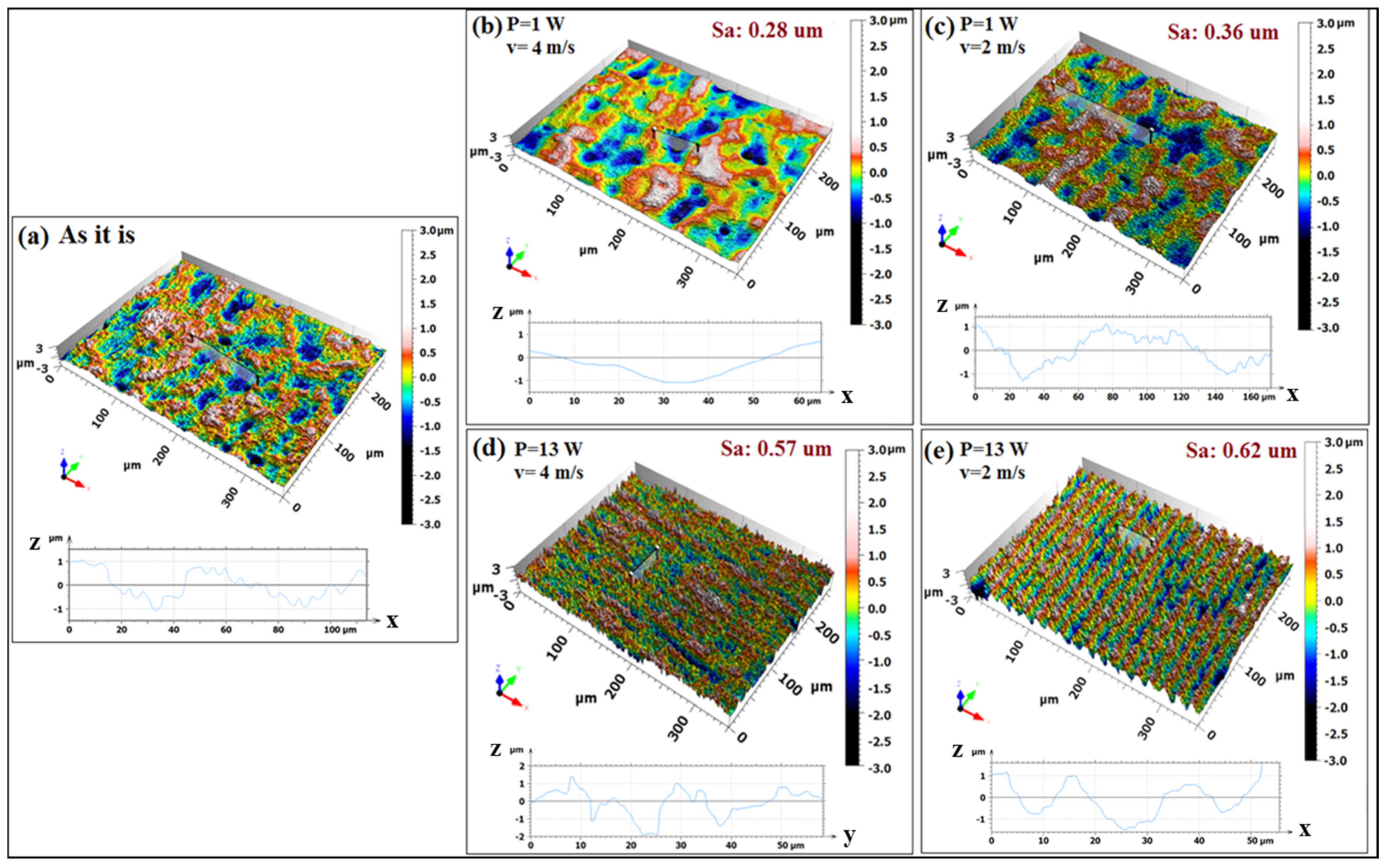
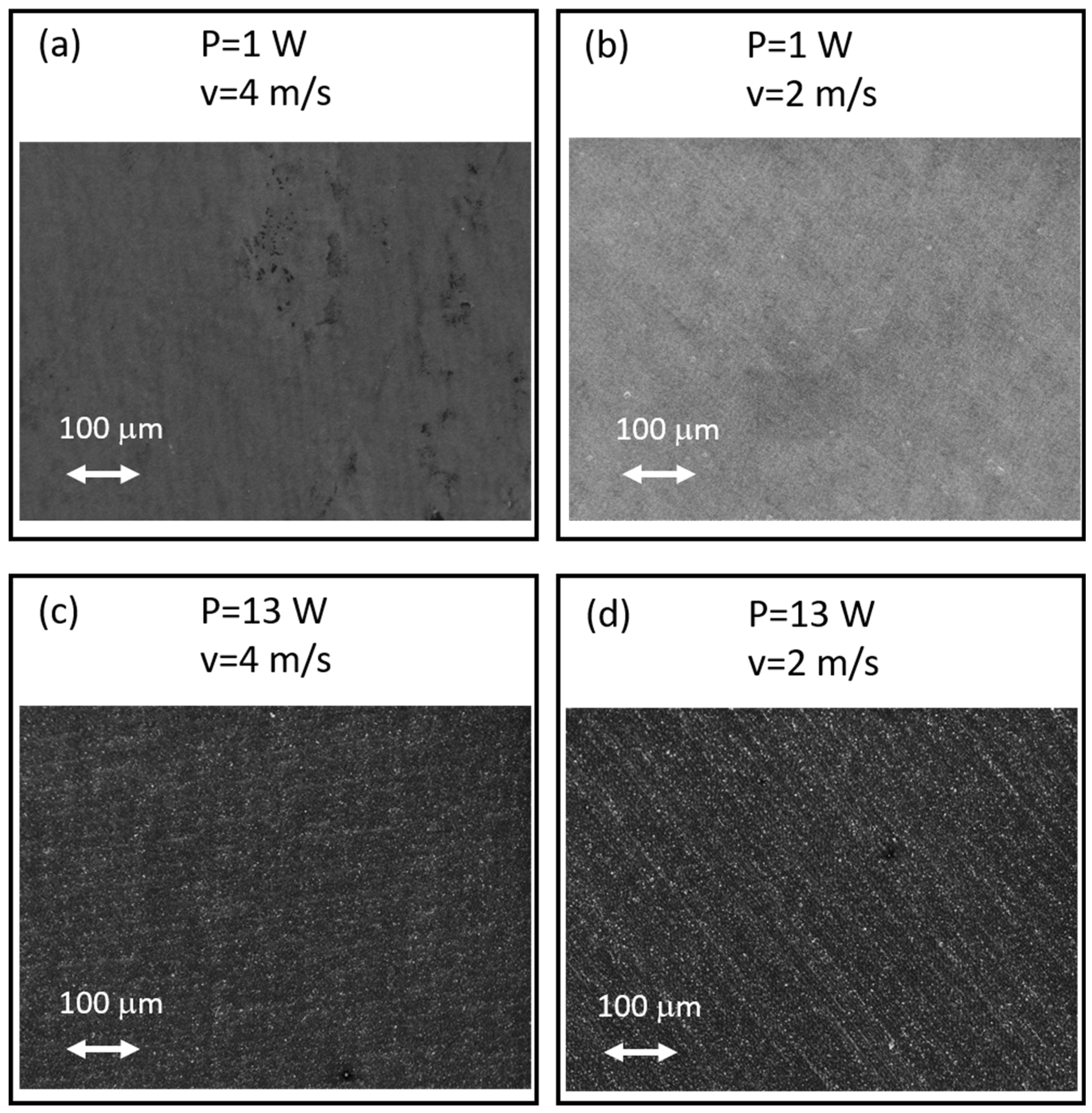
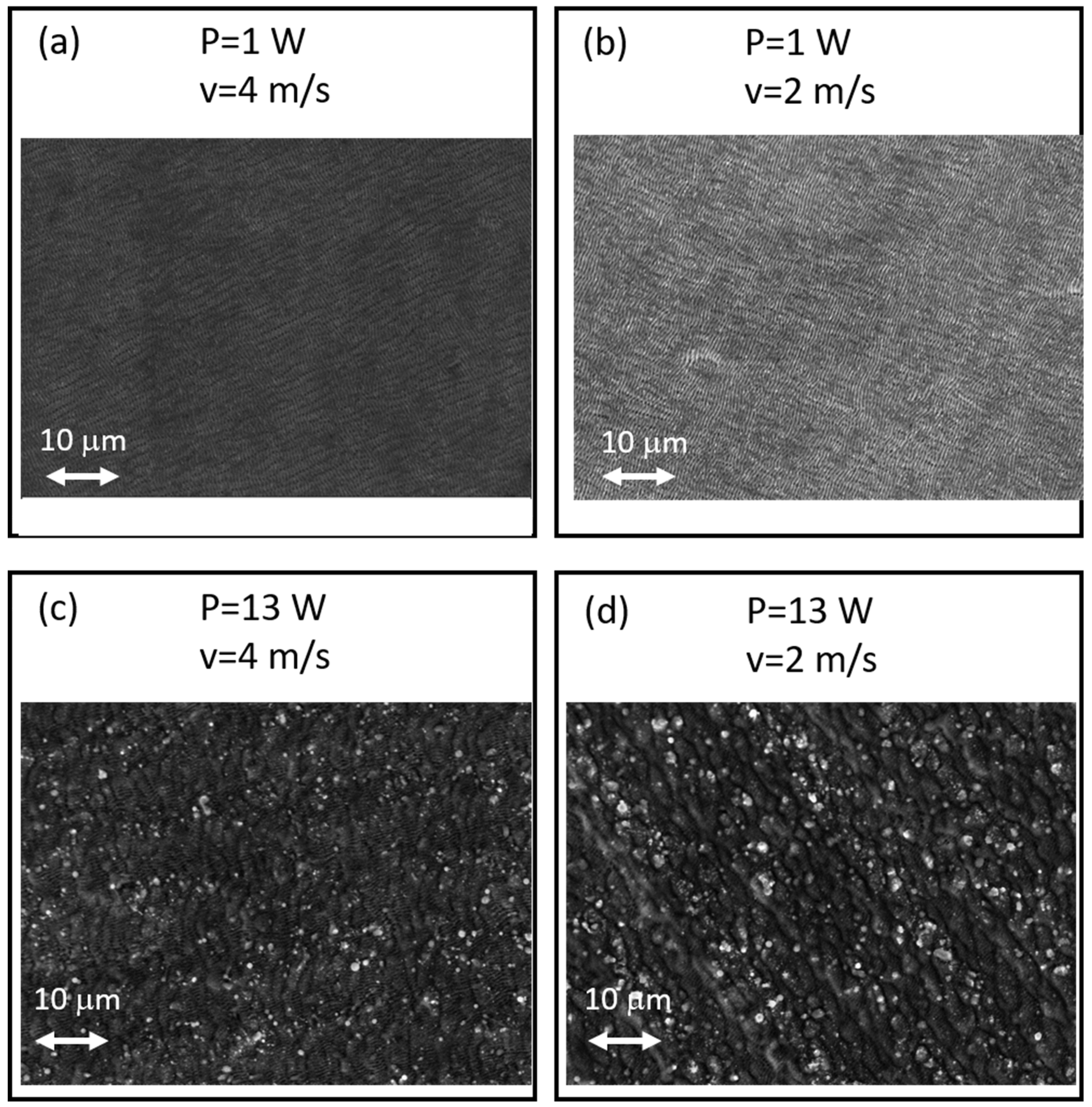

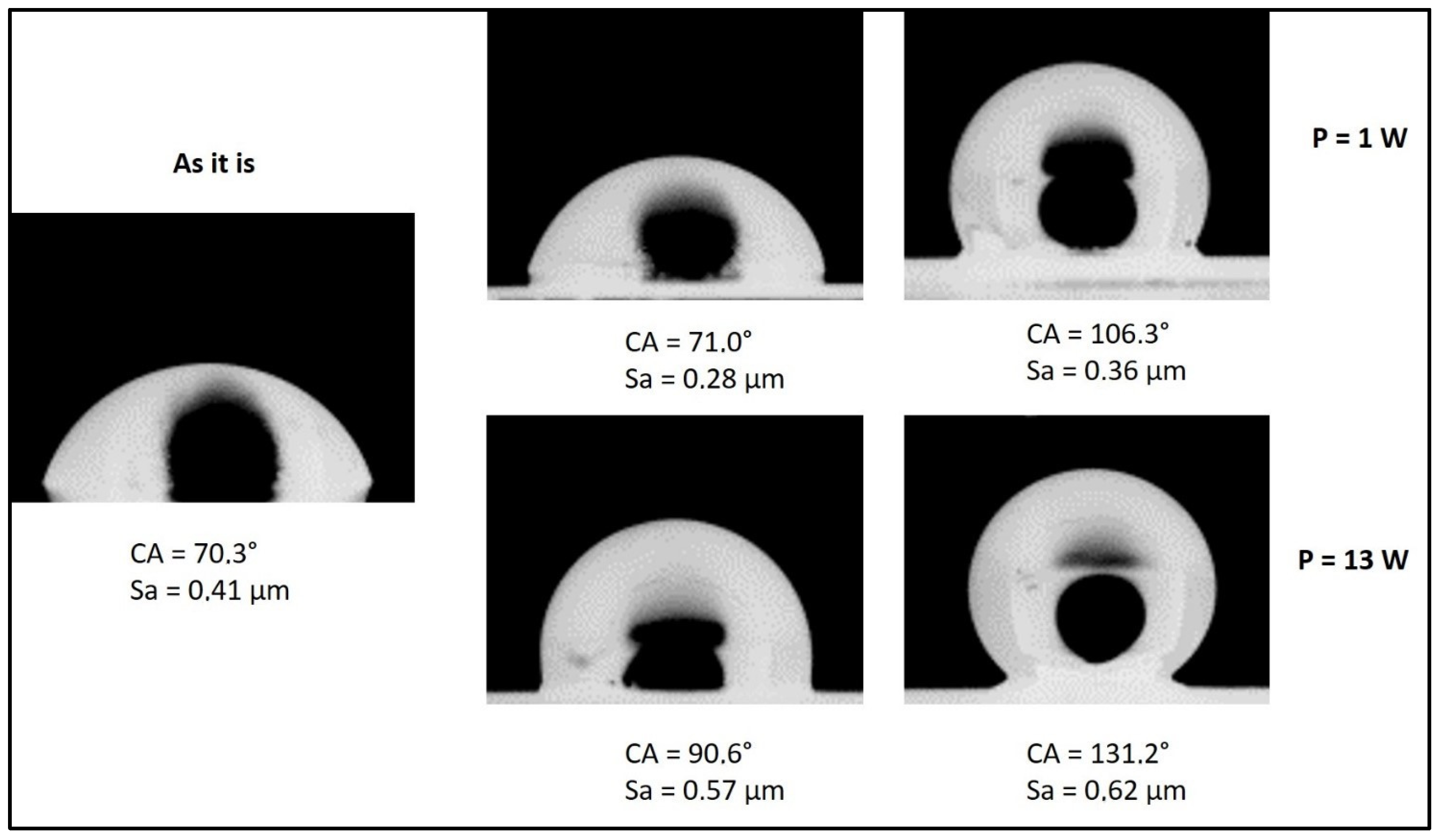
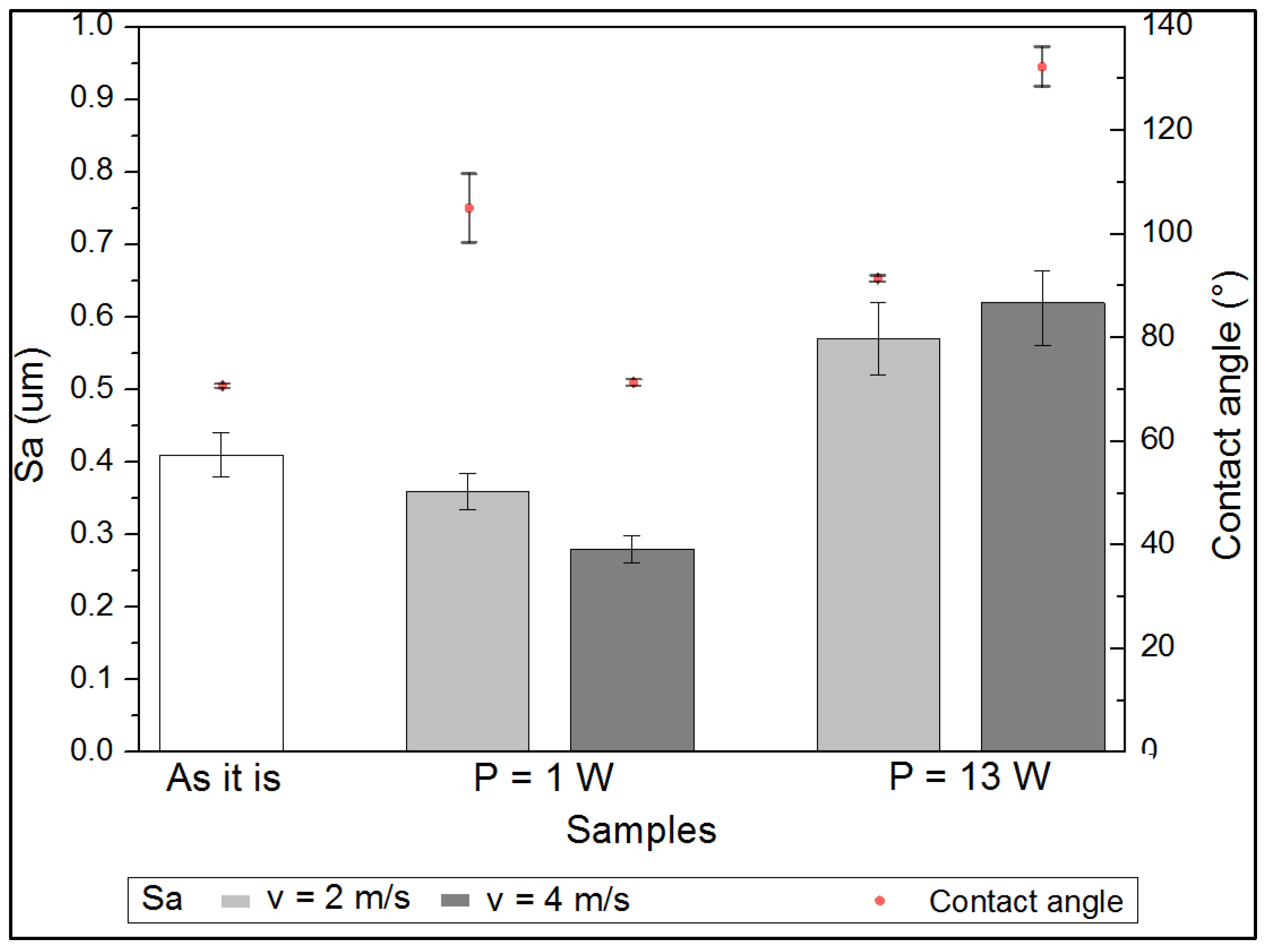

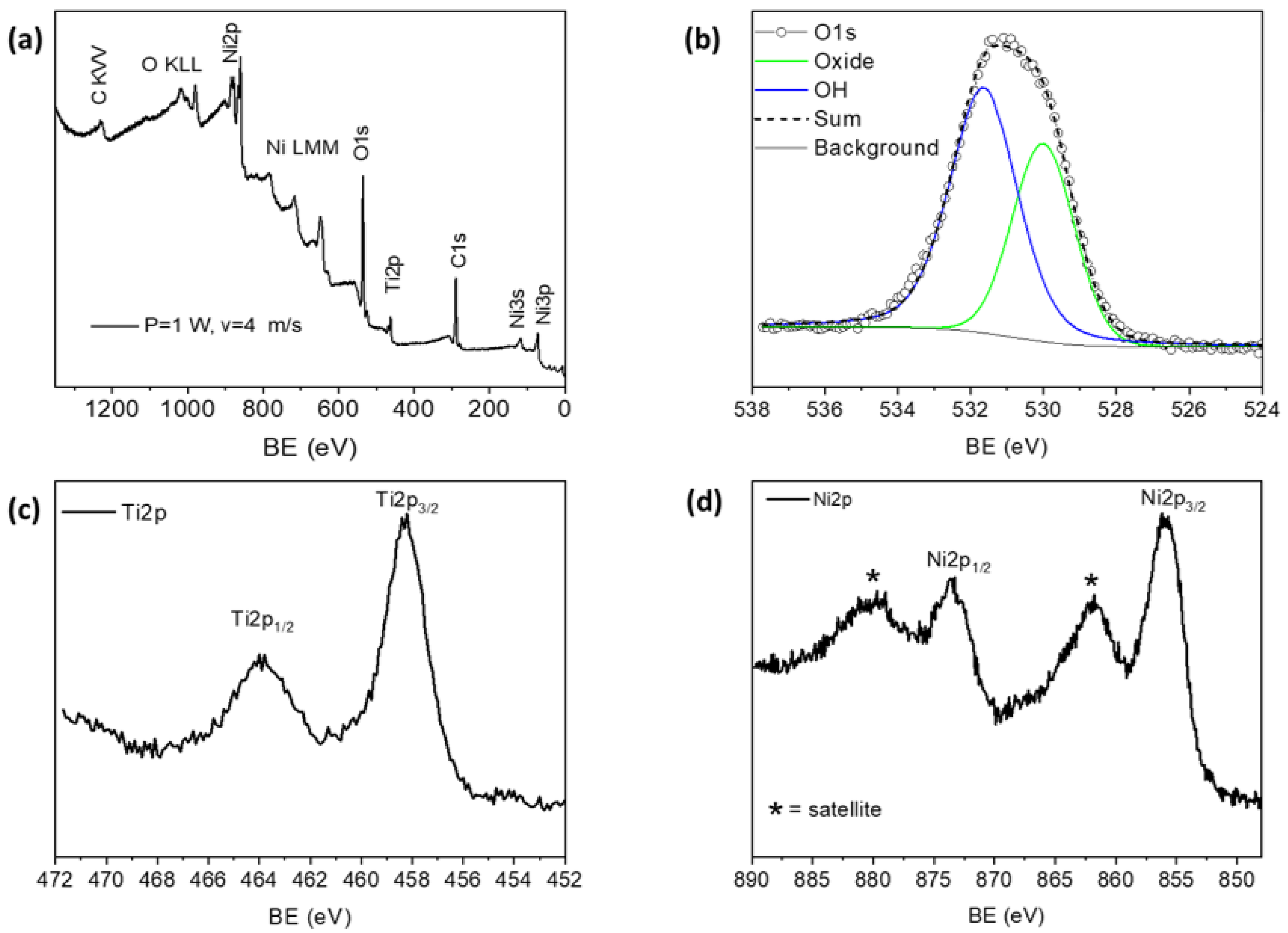
| Characteristic | Values |
|---|---|
| Maximum average power | 15 W |
| Emission wavelength | 1028 nm |
| Maximum pulse energy | 200 μJ |
| Pulse duration range | 210 fs–10 ps |
| Beam quality factor | 1.1 |
| Repetition rate range | Single pulse −200 kHz |
| Parameters | Values |
|---|---|
| Average power | 1–13 W |
| Speed for each pass | 2–4 m/s |
| Pulse duration | 213 fs |
| Laser spot size | 18 μm |
| Repetition rate | 75 kHz |
| Overlapping | 50% |
| E [J/m] | OOX | OOH | Ti 2p3/2 | Ni 2p3/2 | |
|---|---|---|---|---|---|
| Base material | - | 530.1 | 531.6 | 458.1 | 856.0 |
| P = 1 W, v = 4 m/s | 0.25 | 530.0 | 531.6 | 458.2 | 855.8 |
| P = 1 W, v = 2 m/s | 0.5 | 530.1 | 531.5 | 458.5 | 856.0 |
| P = 13 W, v = 4 m/s | 3.25 | 529.8 | 531.4 | 458.2 | 855.7 |
| P = 13 W, v = 2 m/s | 6.5 | 529.9 | 531.5 | 458.1 | 855.7 |
| E [J/m] | C (%) | O (%) | Ti (%) | Ni (%) | Ni/Ti | OH/Ox | |
|---|---|---|---|---|---|---|---|
| Base material | - | 72.3 | 22.7 (Tot) 14.2 (Ox) 8.6 (OH) | 3.5 | 1.5 | 0.4 | 1.7 |
| P = 1 W, v = 4 m/s | 0.25 | 43.5 | 37.7 (Tot) 22.9 (Ox) 17.7 (OH) | 3.0 | 15.8 | 5.3 | 1.6 |
| P = 1 W, v = 2 m/s | 0.5 | 65.3 | 24.6 (Tot) 16.1 (Ox) 8.4 (OH) | 1.7 | 8.4 | 4.9 | 1.9 |
| P = 13 W, v = 4 m/s | 3.25 | 24.9 | 48.1 (Tot) 30.4 (Ox) 17.7 (OH) | 3.5 | 23.5 | 6.8 | 1.7 |
| P = 13 W, v = 2 m/s | 6.5 | 22.2 | 49.1 (Tot) 30.5 (Ox) 18.6 (OH) | 3.5 | 25.2 | 7.3 | 1.6 |
Disclaimer/Publisher’s Note: The statements, opinions and data contained in all publications are solely those of the individual author(s) and contributor(s) and not of MDPI and/or the editor(s). MDPI and/or the editor(s) disclaim responsibility for any injury to people or property resulting from any ideas, methods, instructions or products referred to in the content. |
© 2023 by the authors. Licensee MDPI, Basel, Switzerland. This article is an open access article distributed under the terms and conditions of the Creative Commons Attribution (CC BY) license (https://creativecommons.org/licenses/by/4.0/).
Share and Cite
Biffi, C.A.; Fiocchi, J.; Rancan, M.; Gambaro, S.; Cirisano, F.; Armelao, L.; Tuissi, A. Ultrashort Laser Texturing of Superelastic NiTi: Effect of Laser Power and Scanning Speed on Surface Morphology, Composition and Wettability. Metals 2023, 13, 381. https://doi.org/10.3390/met13020381
Biffi CA, Fiocchi J, Rancan M, Gambaro S, Cirisano F, Armelao L, Tuissi A. Ultrashort Laser Texturing of Superelastic NiTi: Effect of Laser Power and Scanning Speed on Surface Morphology, Composition and Wettability. Metals. 2023; 13(2):381. https://doi.org/10.3390/met13020381
Chicago/Turabian StyleBiffi, Carlo Alberto, Jacopo Fiocchi, Marzio Rancan, Sofia Gambaro, Francesca Cirisano, Lidia Armelao, and Ausonio Tuissi. 2023. "Ultrashort Laser Texturing of Superelastic NiTi: Effect of Laser Power and Scanning Speed on Surface Morphology, Composition and Wettability" Metals 13, no. 2: 381. https://doi.org/10.3390/met13020381






